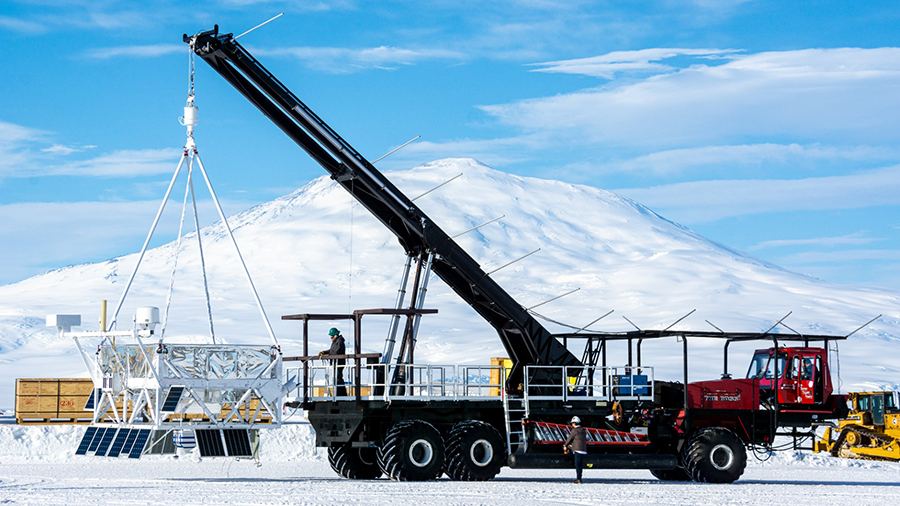
Photo Credit: Mike Lucibella |
The SuperTIGER-II payload is suspended from a crane during a "hang test" at the Long Duration Balloon Facility, with Mount Erebus in the background. |
Heavy Cosmic Rays - Part I: The Flight of SuperTIGER-II
Up in the sky! It's a bird! It's a plane! It's SuperTIGER-II!
By Michael Lucibella, Antarctic Sun Editor
Posted September 14, 2020
In December 2019, SuperTIGER clawed its way back into the upper atmosphere.
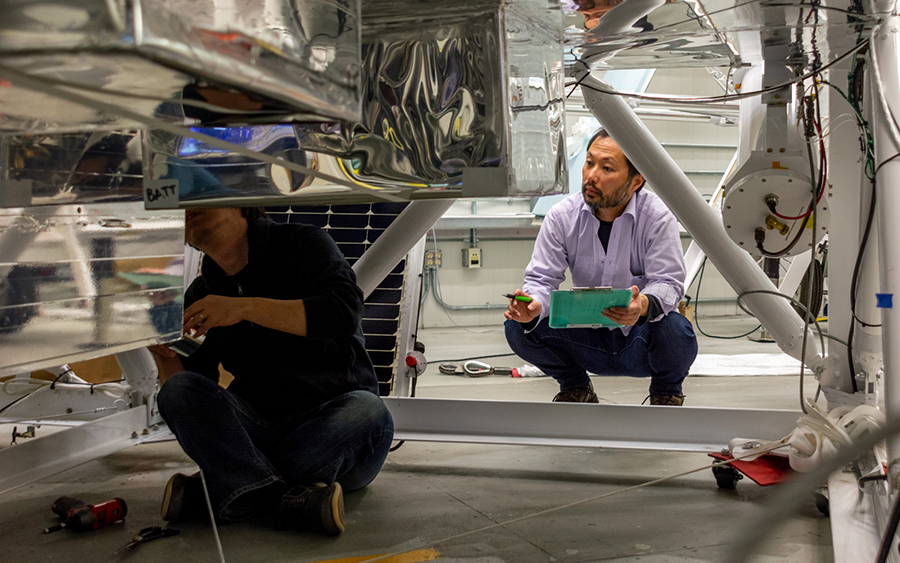
Photo Credit: Mike Lucibella
Kenichi Sakai (left) and Makoto Sasaki work on the underside of the SuperTIGER-II payload inside its hangar bay, as they prepare it for launch.
The second flight of the SuperTIGER cosmic ray experiment, officially dubbed SuperTIGER-II, flew high above the icy continent for more than a month, collecting data on the high-energy particles that zip through the cosmos.
"SuperTIGER is a very large instrument that is balloon-borne, it's flown on a high-altitude balloon over Antarctica," said Robert Binns, an emeritus research professor of physics at Washington University in St. Louis and the original principal investigator on the project. "The objective of it is to measure the abundances of cosmic rays that are heavier than iron."
Cosmic rays are particles that fly through space at nearly the speed of light. Most are essentially the nuclei of various atoms with their electrons sheared off. These charged particles are known as ions, and they range in size from just a single proton core to over a hundred of protons and neutrons bound together.
"We're trying to make the first single-element resolved measurement of these ultra-heavy cosmic rays," said Brain Rauch, a research assistant professor of physics at Washington University in St. Louis and the current principal investigator on the project. "These measurements provide clues about where these cosmic rays come from and how they're accelerated."

Photo Credit: Mike Lucibella
The SuperTIGER-II logo is prominently displayed on one of the trusses that makes up the gondola of the payload.
The NASA-funded project was launched by the Columbia Scientific Balloon Facility at the Long Duration Balloon Facility at McMurdo Station. The National Science Foundation, which manages the U.S. Antarctic Program, is supporting the Antarctic field operations of the project.
Space Nuclei
Despite their name, cosmic rays are actually particles whizzing through the universe. Though most of space is a vacuum, there's a lot of cosmic ray particles constantly zooming through interstellar space.
"The energy in the cosmic ray flux in the galaxy is about the same as the magnetic fields in the galaxy, which is about the same as the energy in starlight in the galaxy. So it's a lot of energy," Rauch said.

Photo Credit: Mike Lucibella
CSBF payload engineer, Curtis Wooten, talks on the radio while checking the telemetry coming in from a test run of SuperTIGER-II's communications systems.
Ninety percent of cosmic ray particles are single protons, essentially ionized hydrogen. Another nine percent is made up of two protons combined with a neutron or two, which is ionized helium. The remaining one percent of cosmic rays are made of the nuclei of other elements from the periodic table of the elements.
"The nuclei lighter than iron have mostly been well measured. The nuclei heavier than iron, they're very rare so they require large instruments," Binns said. "What we are wanting to do is understand the origin of the cosmic rays."
The material that makes up the heavy cosmic rays that Rauch and his team are studying form dying stars larger than the Sun. Stars are powered by nuclear fusion, the intense gravitational pressures at their core force together hydrogen atoms to form helium atoms and releasing vast amounts of energy. As the star ages and it runs out of hydrogen, the heavier leftover elements begin to fuse together and release energy, though not as much. Helium atoms fuse to form carbon, which then form neon, then oxygen, and on down the periodic table.
When the star starts to combine elements to form iron, it loses its ability to sustain itself. Fusing past iron doesn't produce energy for the star, and if it's big enough the star collapses in on itself, then explodes in a bright supernova. This supernova is powerful enough to bombard iron atoms within it with neutrons into even heavier elements. Scientists think that many of the elements heavier than iron were originally formed in the stellar crucible of a supernova.
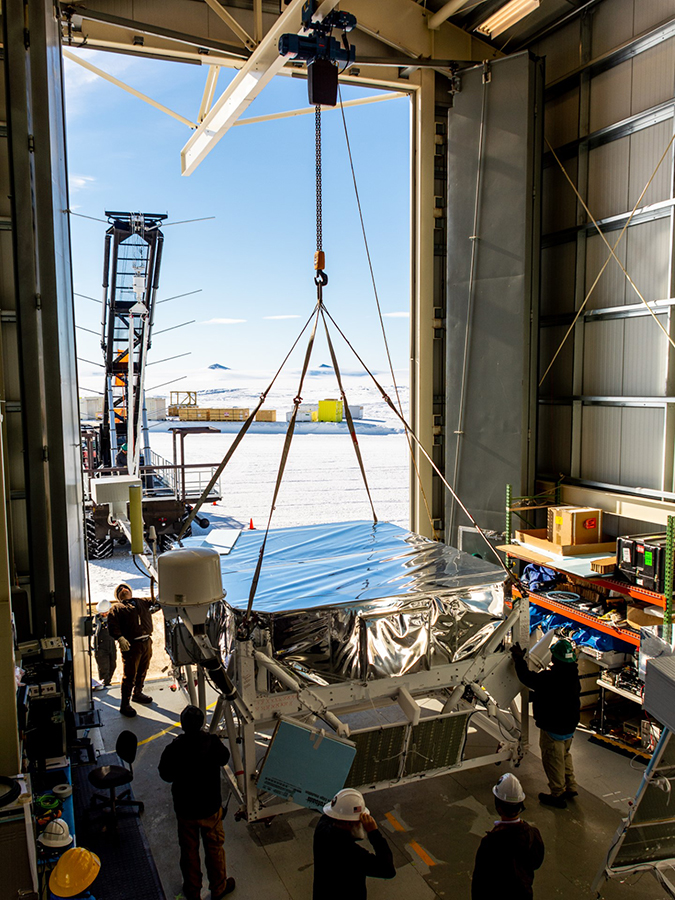
Photo Credit: Mike Lucibella
The SuperTIGER-II payload is lifted out of its hangar bay during a hang test, a required dry run before an actual launch attempt.
Though supernovas produce the raw materials for cosmic rays, according to isotopic cosmic ray observations by Binns and others, they still need something else to push them to their near-light speeds.
"Supernova do not appear to accelerate their own material," Rauch said. "To accelerate the material from a supernova you need another supernova following it."
The shockwave of another supernova sweeping up and accelerating the diffuse remnants of the first is where scientists theorize that most cosmic rays originate from. It seems to make sense as the giant stars that result in supernovas often form in clusters relatively close to each other.
However, confirming this theory by pinpointing the origins of the cosmic ray particles is difficult because cosmic rays don't travel through the universe in a straight line.
"We cannot point with cosmic rays. Because cosmic rays are charged particles, and they travel through the galaxy which has what we would consider a very weak magnetic field, but over light-years distance, the trajectories get bent. So basically, the cosmic rays are diffusing through the galaxy, so there's no pointing information," Rauch said. "We look at the composition of them, the relative abundances of various elements and that gives us clues as to the likely environment that they come from."
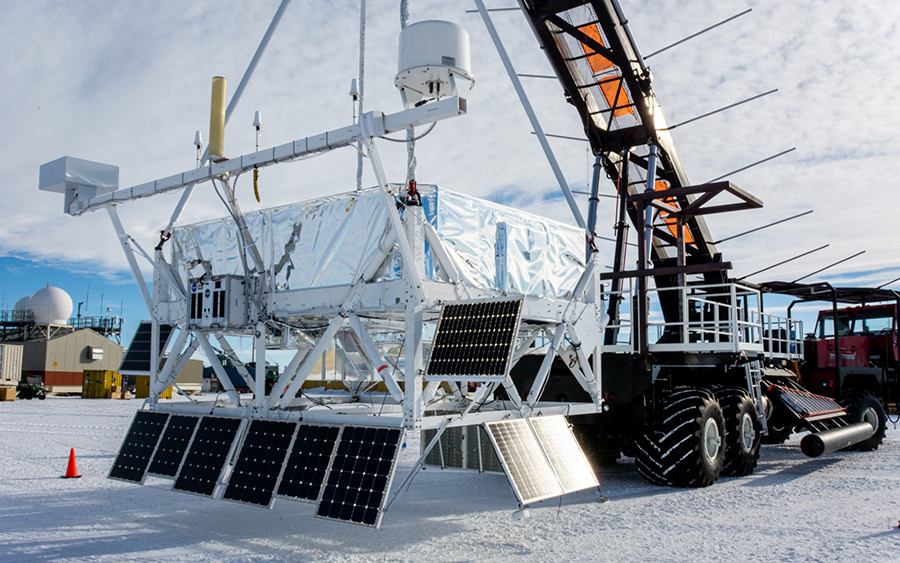
Photo Credit: Mike Lucibella
Outside of its hangar bay, SuperTIGER-II is suspended from the crane during a hang test. During this test, the teams test all of the payload's systems.
Scientists have a good idea of what kinds of cosmic rays should reach Earth based on detailed simulations of the material produced in a supernova, and what they're likely to encounter out in the universe. As they fly through space, heavy elements that pass through interstellar clouds of gas and dust are likely to collide with suspended particles within them, shearing off some of cosmic ray particles' protons and neutrons and breaking them apart into lighter elements, altering the relative abundances of the elements. Comparing what is predicted with what they actually observe ultimately reaching Earth gives them an idea of where the cosmic rays came from, and what they passed through in their journey through the universe.
"By doing a comparison of the relative abundances of cosmic rays in the solar system versus models of production, you can use that to give you an idea of how far the cosmic rays have come and how dense the material is that they went through," Rauch said.
At the Edge of Space

Photo Credit: Richard Bose
The helium balloon used to launch SuperTIGER-II grows to about 150 feet on the ground. In the stratosphere, where there's little surrounding air pressure, it swells to the size of a football field.
The SuperTIGER-II instrument was launched on December 16, 2019, suspended from a helium-filled zero-pressure balloon. The lighter-than-air balloon carried the scientific payload high into the stratosphere at the edge of space. After reaching its cruising altitude of more than 120,000 feet, SuperTIGER-II flew above more than 99 percent of the atmosphere, giving it an unfettered look at the different kinds of cosmic rays passing throughout the solar system.
"The instrument consists of a stack of different detectors," Binns said. The cosmic rays enter from the top of the stack and go through all the detectors."
Because each cosmic ray particle is a positively charged ion, measuring its electrical charge tells scientists how many protons are in each particle, corresponding to which element it is on the periodic table. To do this, there are two basic types of detectors in SuperTIGER-II, a plastic scintillator detector and Cherenkov radiators, which work similarly.
"In each detector they lose energy and the energy that they lose is turned into a light flash in each of these detectors," Binns said. "We have photosensors and photomultiplier tubes that sees that light and turn it onto an electronic signal. Then we can use the signal to have the various detectors in the stack determine the charge of the particle and its energy."
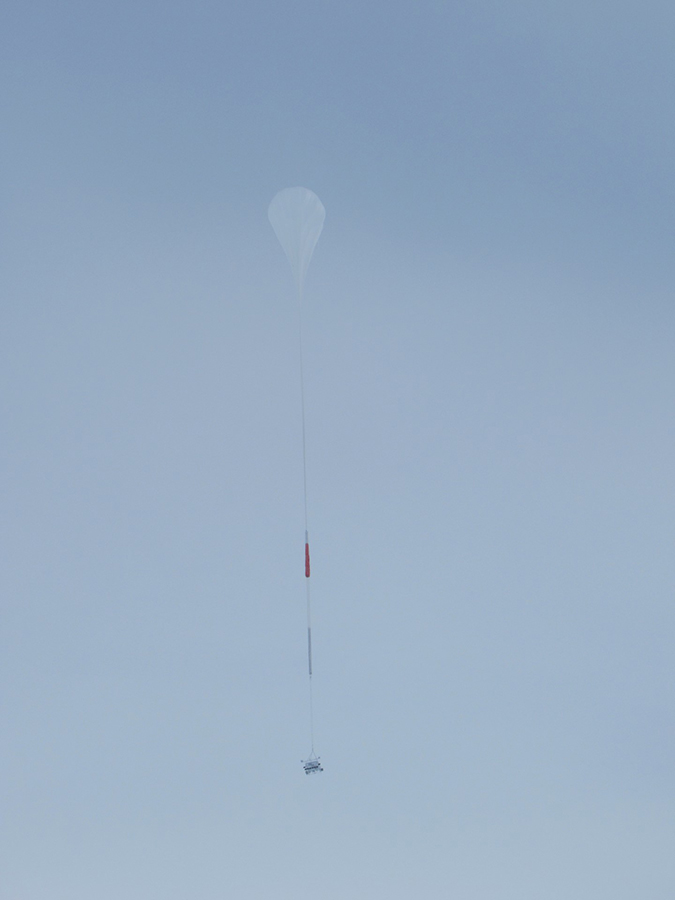
Photo Credit: Richard Bose
The helium balloon carries SuperTIGER-II up to an altitude of about 120,000 feet, above 99 percent of the atmosphere.
The whole payload had to be built tough, because 120,000 feet above sea level is a particularly harsh environment for the sensitive equipment.
"There's no moving parts so we don't have to worry about that, but we do have high voltage so managing that is very difficult because the balloon altitude is like the favorite spot for high voltage to arc," said Richard Bose, a research engineer at Washington University in St. Louis.
In addition, it was a challenge to design the instrument to function in the simultaneous extreme cold of the upper atmosphere and the intense heat of the direct rays of the Sun.
"There's not much air so you can't rely on air to take heat away or average it out for you. You can't use a fan to cool anything," Bose said. "The front part will get to say 30 degrees Celsius [86 degrees Fahrenheit] but the back part might be below zero, so we've got to worry about that. What gets really hot are the solar panels. They get to be 90 degrees Celsius [194 degrees Fahrenheit] up there."
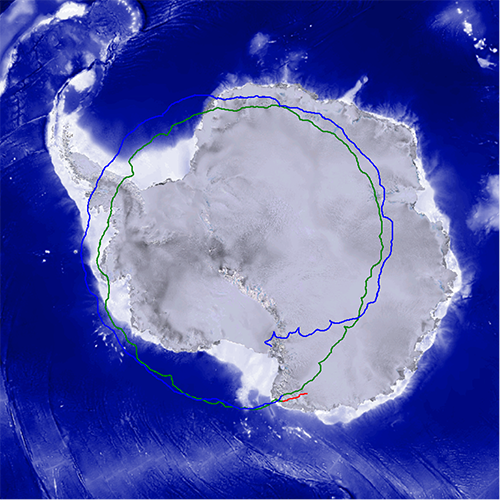
Photo Credit: NASA
After settling into the circumpolar current, a counterclockwise air current that sets up around the pole ever year, SuperTIGER-II made two complete loops around Antarctica over 32 days.
This is the second complete flight of the SuperTIGER payload. The first SuperTIGER mission took place over a record-setting 55 days between December 9, 2012, and February 2, 2013. During that time, the team collected a tremendous amount of data that this recent flight will add to.
"What we've done is extended the range of the particles that we're hoping to look at," Rauch said. "The original program, we were hoping to go out through [element] 40, which is zirconium, and we thought we would need two flights to do that well, but we did that pretty well with one flight. Now we're looking to get farther out."
This year's successful flight comes following two tumultuous seasons for the experiment. In the 2017-2018 summer season, unsuitable weather grounded the balloon the entire season. The following year, the payload was successfully launched on the early morning of December 20 but just hours later the balloon developed problems and had to be brought down and recovered on the far side of the McMurdo Dry Valleys.
This time, the launch went without a hitch. The balloon was aloft and collecting data for 32 days and made two complete circuits around the continent. The payload landed a little ways inland from the Oates Coast in Wilkes Land, only a few hundred miles from McMurdo Station, making recovery of its data drives and ride-along experiments easier.
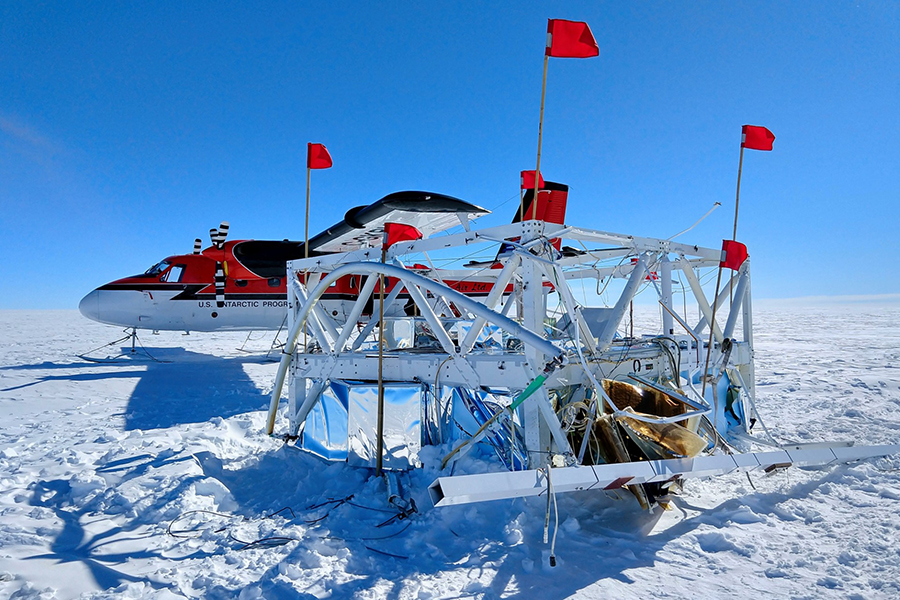
Photo Credit: Scott Battaion
After its month in the air SuperTIGER-II's mission ended and the payload parachuted to the ground. The science team flew in a Twin Otter airplane to retrieve the data from its flight.
"So far, the preliminary instrument level analysis has shown that we collected good data on our second SuperTIGER flight, and that the quality of the data in terms of charge resolution is comparable to what we had in the first flight," Rauch said.
The team is still analyzing their data, but it looks like the data gathered on this flight is well resolved and compliments well what was gathered from the previous flight. They're hoping to soon publish a preliminary analysis of their total measurements from this flight of elements up to Barium, number 56 on the periodic table, then combine their data with the previous flight for a more complete picture of the abundances of the different elements.
The SuperTIGER project is a collaboration among Washington University in St. Louis, NASA's Goddard Space Flight Center, Caltech, and JPL, funded by grants from NASA.














